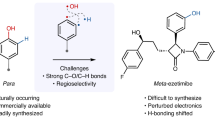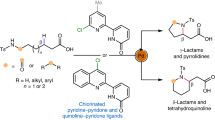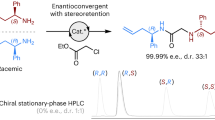Abstract
This protocol describes how to prepare 2-(2-formylalkyl)-arenecarboxylic acid derivatives, common building blocks for the synthesis of various valuable chemicals (e.g., anti-obesity and Alzheimer's disease treatment pharmaceuticals), by using the fully regioselective hydroformylation of vinyl arene derivatives. This catalytic reaction proceeds cleanly with 100% regioselectivity and chemoselectivity. The procedure is reliably scalable and can be efficiently conducted on a multigram scale. The analytically pure product is easily isolated with a nearly quantitative yield by using a simple acid-base extraction workup and avoids any tedious chromatography. This protocol details the synthesis of a bisphosphite ligand (L1) that is a pivotal element of the catalytic system used, Rh(acac)(CO)2 with ligand L1, starting from commercial building blocks. The protocol also describes a general procedure for the preparative hydroformylation of vinylarene-2-carboxylic acid derivatives to 2-formylalkylarene products, providing a representative example for the hydroformylation of 2-vinylbenzoic acid (1a) to 2-(3-oxopropane)-benzoic acid (2a). The synthesis of L1 (six chemical reactions) uses 2-nitrophenylhydrazine, 4-benzyloxybenzoylchloride and (S)-binol, and takes 5–7 working days. The actual hydroformylation reaction of each vinyl arene derivative takes ∼4 h of active effort over a period of 1–3 d.
This is a preview of subscription content, access via your institution
Access options
Subscribe to this journal
Receive 12 print issues and online access
$259.00 per year
only $21.58 per issue
Buy this article
- Purchase on Springer Link
- Instant access to full article PDF
Prices may be subject to local taxes which are calculated during checkout


Similar content being viewed by others
References
Breit, B. & Seiche, W. Recent advances on chemo-, regio- and stereoselective hydroformylation. Synthesis 2001, 1–36 (2001).
Cai, C., Yu, S., Cao, B. & Zhang, X. New tetraphosphorus ligands for Highly linear selective hydroformylation of allyl and vinyl derivatives. Chem. Eur. J. 18, 9992–9998 (2012).
Franke, R., Selent, D. & Börner, A. Applied hydroformylation. Chem. Rev. 112, 5675–5732 (2012).
Nelsen, E.R. & Landis, C.R. Interception and characterization of alkyl and acyl complexes in rhodium-catalyzed hydroformylation of styrene. J. Am. Chem. Soc. 135, 9636–9639 (2013).
Peng, W.-J. & Bryant, D.R. Preparation of novel phosoxophite ligands and use thereof in carbonylation processes. Uniform Commercial Code (UCC) international patent WO 2003/78444 (2003).
Jennerjahn, R. et al. Palladium-catalyzed isomerization and hydroformylation of olefins. Chem. Eur. J. 15, 6383–6388 (2009).
Duerfeldt, A.S., Brandt, G.E.L. & Blagg, B.S.J. Design, synthesis, and siological evaluation of conformationally constrained cis-amide Hsp90 Inhibitors. Org. Lett. 11, 2353–2356 (2008).
Spletstoser, J.T., White, J.M., Rao Tunoori, A. & Georg, G.I. Mild and selective hydrozirconation of amides to aldehydes using Cp2Zr(H)Cl: scope and mechanistic insight. J. Am. Chem. Soc. 129, 3408–3419 (2007).
Colbon, P., Ruan, J., Purdie, M., Mulholland, K. & Xiao, J. Double arylation of allyl alcohol via a one-pot Heck arylation–isomerization–acylation cascade. Org. Lett. 13, 54 (2011).
Ringe, D. & Petsko, G.A. How enzymes work. Science 320, 1428–1429 (2008).
Dydio, P., Dzik, W.I., Lutz, M., de Bruin, B. & Reek, J.N.H. Remote supramolecular control of catalyst selectivity in the hydroformylation of alkenes. Angew. Chem. Int. Edn. 50, 396–400 (2011).
Dydio, P., Detz, R.J. & Reek, J.N.H. Precise supramolecular control of selectivity in the Rh-catalyzed hydroformylation of terminal and internal alkenes. J. Am. Chem. Soc. 135, 10817–10828 (2013).
Dydio, P., Ploeger, M. & Reek, J.N.H. Selective isomerizationhydroformylation sequence: a strategy to valuable α– methyl-branched aldehydes from terminal olefins. ACS Catal. 3, 2939–2942 (2013).
Dydio, P. & Reek, J.N.H. Supramolecular control of selectivity in hydroformylation of vinyl arenes: easy access to valuable β-aldehyde intermediates. Angew. Chem. Int. Ed. 52, 3878–3882 (2013).
Hiraiwa, Y., Morinaka, A., Fukushima, T. & Kudo, T. Metallo-β-lactamase inhibitory activity of phthalic acid derivatives. Bioorg. Med. Chem. Lett. 19, 5162–5165 (2009).
Duerfeldt, A.S. et al. Development of a Grp94 inhibitor. J. Am. Chem. Soc. 134, 9796–9804 (2012), and references therein.
Deadman, J.J. et al. Preparation of imidazopyrimidinone derivatives as antiviral agents against HIV or simian immunodeficiency virus (SIV). international patent WO 2010/000031 (2010).
John, V. et al. Preparation of hydroxyethylamines as aspartyl protease inhibitors for treatment of amyloidosis. international patent WO 2005/087751 (2005).
Pfefferkorn, J.A. et al. Design and synthesis of novel, conformationally restricted HMG-CoA reductase inhibitors. Bioorg. Med. Chem. Lett. 17, 4531–4537 (2007).
Zhou, J., Matos, M.-C. & Murphy, P.V. Synthesis of a benzomacrolactone-based somatostatin mimetic. Org. Lett. 13, 5716–5719 (2011).
Mihalic, J.T. et al. Discovery of a new class of ghrelin receptor antagonists. Bioorg. Medicinal Chem. Lett. 22, 2046–2051 (2012).
Arockiam, P.B., Bruneau, C. & Dixneuf, P.H. Ruthenium(II)-catalyzed C–H bond activation and functionalization. Chem. Rev. 112, 5879–5918 (2012).
Song, G., Wang, F. & Li, X. C–C, C–O and C–N bond formation via rhodium(III)-catalyzed oxidative C–H activation. Chem. Soc. Rev. 41, 3651–3678 (2012).
Lee, D.-H., Kwon, K.-H. & Yi, C.S. Selective catalytic C–H alkylation of alkenes with alcohols. Science 333, 1613–1616 (2011).
Dydio, P., Lichosyt, D., Zieliński, T. & Jurczak, J. 7,7′-Diamino-2,2′-diindolylmethane: a building block for highly efficient and selective anion receptors—studies in solution and in the solid state. Chem. Eur. J. 18, 13686–13701 (2012).
Acknowledgements
We acknowledge the Dutch National Research School Combination Catalysis Controlled by Chemical Design (NRSC-Catalysis) for financial support.
Author information
Authors and Affiliations
Contributions
P.D. designed and carried out the experiments, and wrote the paper. J.N.H.R. designed the experiments and wrote the paper.
Corresponding author
Ethics declarations
Competing interests
The authors declare no competing financial interests.
Rights and permissions
About this article
Cite this article
Dydio, P., Reek, J. Scalable and chromatography-free synthesis of 2-(2-formylalkyl)arenecarboxylic acid derivatives through the supramolecularly controlled hydroformylation of vinylarene-2-carboxylic acids. Nat Protoc 9, 1183–1191 (2014). https://doi.org/10.1038/nprot.2014.077
Published:
Issue Date:
DOI: https://doi.org/10.1038/nprot.2014.077
This article is cited by
-
A domino reaction for generating β-aryl aldehydes from alkynes by substrate recognition catalysis
Nature Communications (2019)
Comments
By submitting a comment you agree to abide by our Terms and Community Guidelines. If you find something abusive or that does not comply with our terms or guidelines please flag it as inappropriate.



